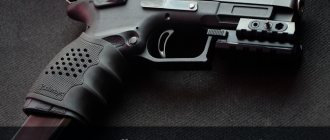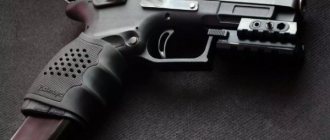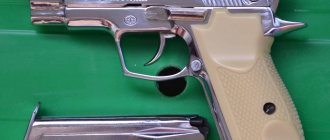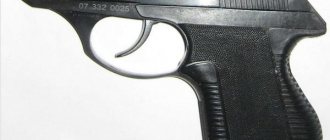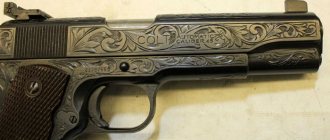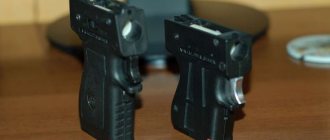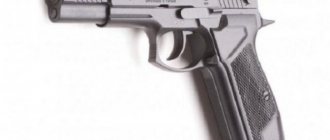The Stalker traumatic pistol, according to the manufacturer, belongs to the class of a compact weapon for concealed carry and civil self-defense. However, any potential buyer, seeing this weapon for the first time, immediately understands that there is no smell of any compact class here. The body of this gun is based on TsAM alloys, in contrast to the use of steel in the production of similar pistols. This raises the main question: what was the point of using TsAM alloys instead of steel, which led to a reduction in the life of the weapon.
History of the pistol
Traumatika Stalker is one of the most compact pistols. There are no combat analogues of this weapon, although, of course, there is an external resemblance to certain rifled pistols. This model appeared on the domestic market in 2008.
If you look closely at the design of the Stalker traumatic gun, you will see that this pistol and the Streamer model are almost identical and differ only in size and number of cartridges in the magazine. The Stalker has a double-stack 10-round clip, while its larger brother the Streamer has a 14-round clip.
The weight of the pistol with loaded cartridges is approximately 0.7 kg. The weapon was produced only in black and has now been discontinued, although it can still be found on store shelves.
Aluminum alloys (TsAM) are widely used in the design of the Stalker model. The bolt frame of the pistol is equipped with a metal frame, which is filled with light alloys and reinforced with steel inserts.
The inner surface of the barrel channel in places of maximum load of powder gases (breech) is metal. The muzzle and outer part of the barrel are made of TsAM material. In the USM, only the firing pin is made entirely of steel; the remaining elements of the trigger mechanism are aluminum alloys.
Information about the metal frame and reinforced inserts is provided by the manufacturer, and it is not physically possible to check for yourself how this reinforcement is made. The design of the barrel channel of the Stalker traumatic gun is not very common for the domestic market of pistols for firing rubber cartridges.
The barrel contains two protrusions located opposite each other (the so-called “teeth”) and one section in the shape of a cylinder, its diameter is 1 cm. According to the idea of the developer’s company, when a bullet passes through the protrusions, kinetic energy is created as powder gases escape. And passing through the barrel cylinder, the bullet flies further without touching the walls, this allows for stable operation of the weapon’s automation, and the straight section stabilizes the bullet and increases the accuracy of the shot.
A review and shooting of the Stalker traumatic pistol can be seen in this video:
Traumatic pistol Stalker
The Stalker traumatic pistol, according to the manufacturer, belongs to the class of a compact weapon for concealed carry and civil self-defense. However, any potential buyer, seeing this weapon for the first time, immediately understands that there is no smell of any compact class here. The body of this gun is based on TsAM alloys, in contrast to the use of steel in the production of similar pistols. This raises the main question: what was the point of using TsAM alloys instead of steel, which led to a reduction in the life of the weapon.
Technical characteristics Stalker
| Characteristic | Parameter |
| Overall gun length | 14 cm |
| Height | 10.9 cm |
| Width | 3.5 cm |
| Caliber | 10x22T |
| Barrel length | 6.1 cm |
| Number of cartridges in the magazine | 10 pieces |
| Weight without loaded clip | 0.6 kg |
| Fire mode | Single shooting |
Design
Traumatika Stalker, according to the manufacturer, is a small-sized weapon for concealed carry and self-defense. But every potential buyer, seeing this pistol for the first time, can immediately understand that this product does not belong to any compact class. The body of this model is based on TsAM material, in contrast to the traditional use of metal during the manufacture of similar weapons. This leads to the main drawback - a decrease in the service life of the pistol.
At the time of manufacture, this traumatic pistol was an attractive product on the arms market. It would still be a good option today thanks to the small partitions in the barrel channel, if TsAM had not been used during the manufacture of weapons. It cannot be said that the use of such a material is critical for a pistol, but this alloy must be used within reasonable limits.
Just certain mechanisms are made of metal, but this is not enough for a pistol. The main components that withstand high pressure when fired are made of aluminum alloys, this significantly reduces their service life.
It seems that this fact defines the Stalker as a “bad” pistol, but this is completely false.
Yes, the main disadvantage of this pistol is the use of a TsAM, but it has many advantages that cover the features of this design. This weapon is simply a good option as a primary pistol for self-defense. It cannot be used for recreational or training shooting; it is intended only for self-defense.
Design Features:
- First, you need to note the amount of ammunition in the Stalker trauma magazine. Despite its small dimensions, the clip holds 10 rounds, which is certainly an advantage.
- The thickness of the pistol handle itself is 3.4 cm. Thanks to this width and ergonomic shape, the operation of the pistol turned out to be very comfortable, especially since this design is complemented by a “heel”. It must be said that due to the thickness of the handle, this weapon cannot be carried concealed in a pocket.
- The weight of the pistol without a loaded magazine is 0.65 kg. That is, it will be difficult to carry a pistol without the help of a holster. Taking this into account, we can draw a conclusion.
- Stalker - does not belong to the compact class of pistols, but it can be classified as a weapon of the smallest possible size. The total length of this model is 14 cm and the height is 10.9 cm. This figure is smaller than most other trauma devices, but this is not enough for maximum compactness; for example, the WASP-R model has smaller dimensions.
As for carrying this weapon, a large assortment of holsters has been developed for the Stalker. Some are even used in the summer, when the pistol owner wears mostly light clothing. However, in the summer, you can use larger traumatic weapon models, which will be as noticeable as the Stalker model.
general information
At the time of its release, this weapon was a very good and attractive option on the market. It would still be an excellent option due to its small barrier inside the barrel, if not for the use of TsAM in the production of the pistol. Not to say that the use of this particular option is critical for the weapon, but such an alloy must be used wisely.
The fact is that some parts of the pistol are made of steel, but this is not enough. The components that bear the main load during firing are made of TsAM alloys, which significantly reduces their service life.
It would seem that this circumstance defines this pistol as “bad”, but this is far from the case. Yes, its main drawback lies precisely in the TsAM, but it has a lot of advantages that can overcome this drawback. The fact is that this pistol is an excellent option for a self-defense weapon. It should not be used for sport or recreational shooting, only for self-defense.
Dismantling Stalker
There are many conflicting opinions regarding the advisability of cleaning and lubricating pistols that are made of aluminum alloy. The only correct recommendation is that each traumatic gun needs to be lubricated and cleaned after use.
For cleaning you will need the Stalker traumatik itself, neutral weapon oil and a kit designed for cleaning 9 mm weapons. Regular ear cleaning sticks are also useful; they can be bought at any pharmacy. To clean the weapon after each shooting, you will need to partially disassemble the Stalker pistol, for this you need:
- remove the clip from the pistol;
- put the fuse in the firing position;
- make sure that there is no cartridge in the chamber by distorting the bolt frame;
- pull the shutter slightly towards you, and fix it in this position, remove the shutter delay lever;
- pull the bolt frame all the way, lift its rear part, so it will be removed from the guides;
- carefully release the bolt frame forward and remove it from the barrel;
- remove the return spring.
Reassembling the weapon is done in the reverse order.
A complete disassembly of the Stalker traumatic pistol can be seen in this video:
Recommendations before purchasing Stalker
The number of rounds in the magazine is 10 pieces - this is a unique advantage. It’s just that in a real unpleasant situation, when it is necessary to use a traumatic weapon, most often 4-5 rounds are enough, especially if reinforced ammunition is used. However, in this case, human psychology is important - the owner of a traumatic weapon with 10 rounds of ammunition feels much calmer, unlike the owner of a pistol with 6 rounds of ammunition in the clip.
Despite the use of TsAM alloy during the manufacture of weapons, it is subject to the same criteria when choosing cartridges as for a traumatic pistol, which is made of metal. For self-defense, you need to choose reinforced cartridges of 10x22T caliber, but for recreational shooting, weak ammunition is enough.
Possible problems during operation
The Stalker pistol has a problem inherent in most models of traumatic weapons - a standard recoil spring installed at the factory. It is intended to use weak ammunition. The spring is quite flimsy, so it is prohibited to use it with reinforced cartridges - this can lead to swelling of the cartridges or completely rupture the barrel, which will render the pistol inoperable.
Solving this issue is not difficult, if you need to install reinforced cartridges - you need to replace the return spring with a more elastic one. In this case, no troubles will arise during shooting.
But we must remember that if you need to shoot weak ammunition again, you need to put back the standard spring, since it is not recommended to shoot weak cartridges with a stiff spring; the pistol may not be reloaded.
The advantages of the Stalker traumatic weapon include the “omnivorous” nature of the weapon. It’s just that the pistol can use 9mm R.A. cartridges. But we must not forget that the use of any ammunition in this pistol, with the exception of 10x22T, is punishable by law, so choose 9 mm R.A. Only needed for recreational shooting. They don’t make much sense, but probably many will want to experiment.
How to properly care
Traumatika Stalker has some features that need to be taken into account during operation and fine-tuning of the pistol. The main reason for this is the material used to make the weapon.
To begin with, what the owners of a traumatic pistol do after purchasing it is polishing all mechanisms and components, especially those exposed to high pressure of powder gases. This will make the weapon operate much smoother. However, this is done in cases where the product is made of metal; Stalker, as mentioned above, is made of aluminum alloys. Grinding its mechanisms is not prohibited, but it is not recommended.
Simply by grinding components that are made of alloys, they can break. The likelihood of such an outcome increases if the owner of the weapon receives a not very high-quality product. But, despite the poor quality material that was used during manufacturing, the weapon itself was assembled at the factory with high quality.
As mentioned above, when choosing the correct recoil spring for the ammunition used, the Stalker will not inflate cartridges, however, its resource is limited to 3500 shots with reinforced cartridges. Naturally, this amount is sufficient for self-defense, but this figure is considered minimal for injury.
Another weak point of this Stalker is the trigger mechanism. In this case, it is also due to the material used to make the weapon. Moreover, this problem is caused not by shooting, but by dirt. If you do not clean it regularly, the trapped dirt will quickly damage the trigger mechanism. Moreover, in order to bring the gun back to life, it will need to be completely replaced.
When buying a Stalker pistol, you need to prepare for the fact that regular cleaning of the weapon will most likely be the most frequent activity during its use. At the same time, taking into account the operating manual, it is not recommended to disassemble the gun frequently, but this is required during regular cleaning. This is the main paradox of Stalker.
What can be concluded?
At the end of this review I would like to make an abbreviated summary. The main advantages of this weapon are as follows:
- Small size;
- Store capacity;
- Low cost;
- Minor obstructions in the trunk;
- High level of build quality.
Speaking about the positive aspects, one cannot fail to mention the negative ones, which are as follows:
- Material used in production;
- Low working resource;
- Rapid wear of components;
- Inability to use powerful charges with a standard return spring;
- High degree of influence of dirt on the service life of parts.
Thus, as I already said, this pistol is a good option if you choose it as an additional means of self-defense if you have a more powerful and reliable weapon. Using the Stalker as the main weapon is not recommended, although no one prohibits it.
